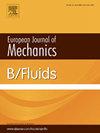Analysis of multi-field cavitation structure and dynamic mode decomposition based on a separated venturi cavitation generator
IF 2.5
3区 工程技术
Q2 MECHANICS
引用次数: 0
Abstract
Cavitation is generated due to the reduction of fluid pressure, which will cause instability and erosion inside the pipeline, valve or pump etc. In this paper, based on the improved venturi cavitation generator, the cavitation under several different flow conditions is studied, and a high-speed camera is used to capture the dynamic process of cavitation at the venturi throat. The flow field simulation data have been analysed using the dynamic mode decomposition method, and the coherent structures of sheet cavitation, transition zone cavitation, and cloud cavitation and their displacements with cycle time have been investigated. The periodic variation of cavitation is analysed using a combination of experimental and numerical simulations, and the state of cavitation in the flow field is investigated in detail using data-driven tools. The results show that periodic changes in the cavitation structure can be observed intuitively through the improved venturi generator and agrees well with the results of simulation. Cavitation intensity is continuously enhanced with the increase of inlet velocity. At flow velocity of 4.68 m/s, the cavitation is manifested as a piecewise cavitation that can only be observed at the throat position, since then the length of the cavitation cloud continues to increase, finally the detachment of a bubble cloud and localized vortex cavitation are observed at velocity of 6.08 m/s. The frequency and growth characteristics of individual flow modes can be accurately captured using the dynamic modal decomposition of the flow field.
基于分离文丘里空化发生器的多场空化结构分析及动态模态分解
气蚀是由于流体压力降低而产生的,它会引起管道、阀门或泵等内部的不稳定和侵蚀。本文基于改进的文丘里腔空化发生器,研究了几种不同流动条件下的空化现象,并利用高速摄像机捕捉了文丘里腔喉处空化的动态过程。采用动态模态分解方法对流场模拟数据进行了分析,研究了片状空化、过渡区空化和云状空化的相干结构及其随循环时间的位移。采用实验与数值模拟相结合的方法分析了空化的周期性变化,并利用数据驱动工具对流场中的空化状态进行了详细研究。结果表明,通过改进的文丘里管发生器可以直观地观察到空化结构的周期性变化,与仿真结果吻合较好。随着进口速度的增加,空化强度不断增强。在流速为4.68 m/s时,空化表现为分段空化,只能在喉道位置观察到,此后空化云的长度不断增加,最终在流速为6.08 m/s时观察到气泡云的脱离和局部涡空化。利用流场的动态模态分解可以准确地捕捉到单个流模的频率和增长特性。
本文章由计算机程序翻译,如有差异,请以英文原文为准。
求助全文
约1分钟内获得全文
求助全文
来源期刊
CiteScore
5.90
自引率
3.80%
发文量
127
审稿时长
58 days
期刊介绍:
The European Journal of Mechanics - B/Fluids publishes papers in all fields of fluid mechanics. Although investigations in well-established areas are within the scope of the journal, recent developments and innovative ideas are particularly welcome. Theoretical, computational and experimental papers are equally welcome. Mathematical methods, be they deterministic or stochastic, analytical or numerical, will be accepted provided they serve to clarify some identifiable problems in fluid mechanics, and provided the significance of results is explained. Similarly, experimental papers must add physical insight in to the understanding of fluid mechanics.

 求助内容:
求助内容: 应助结果提醒方式:
应助结果提醒方式:


